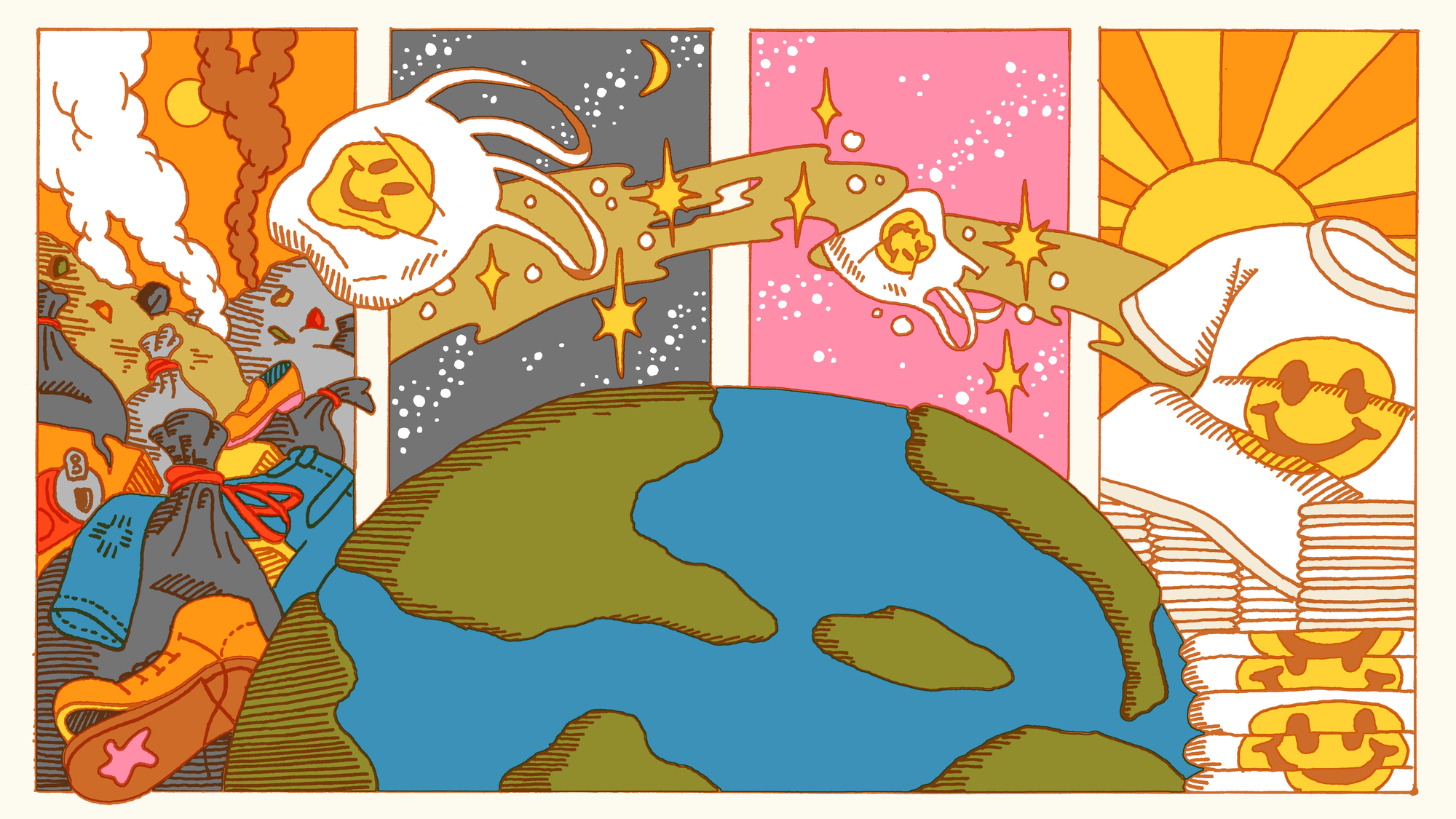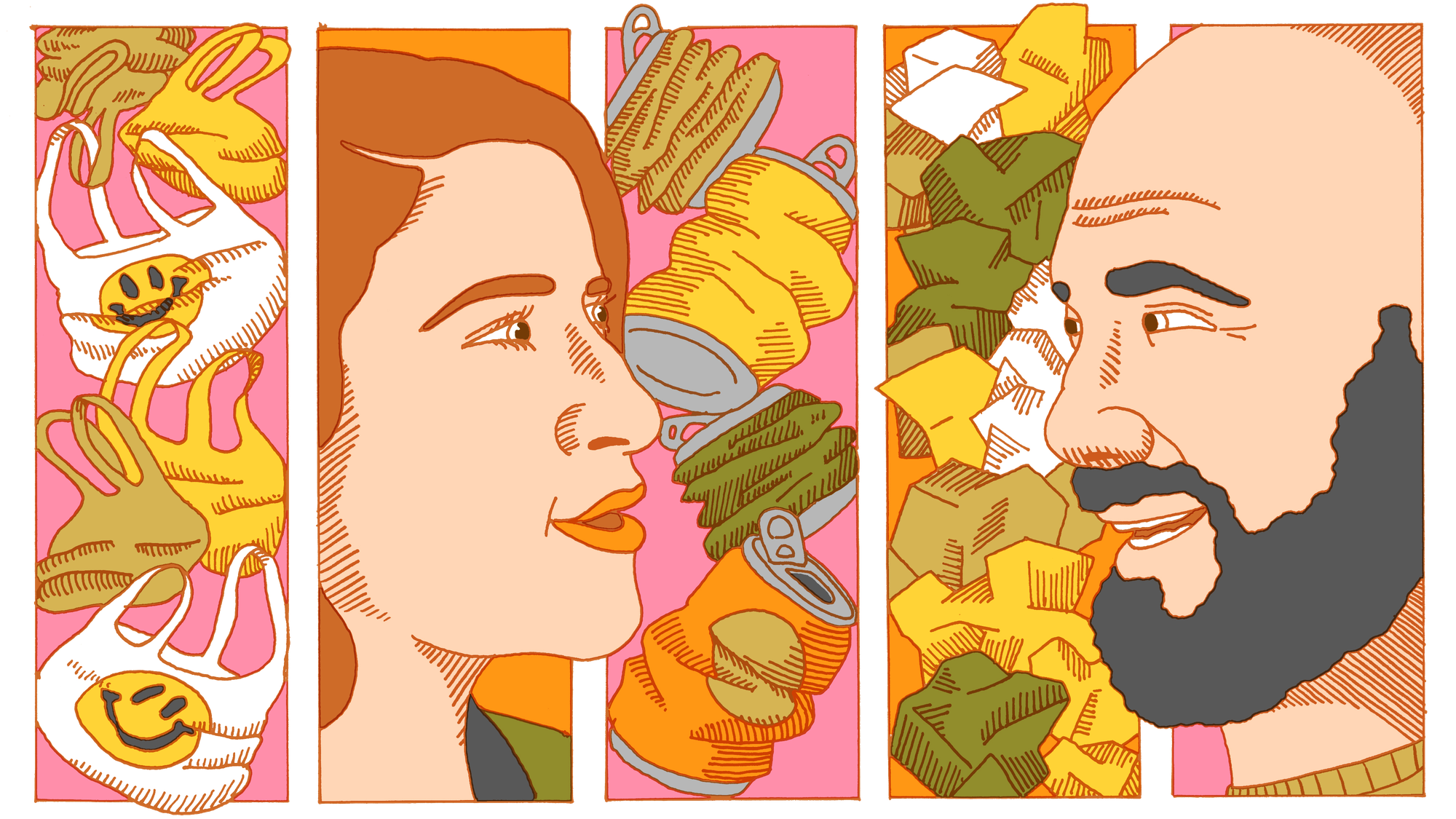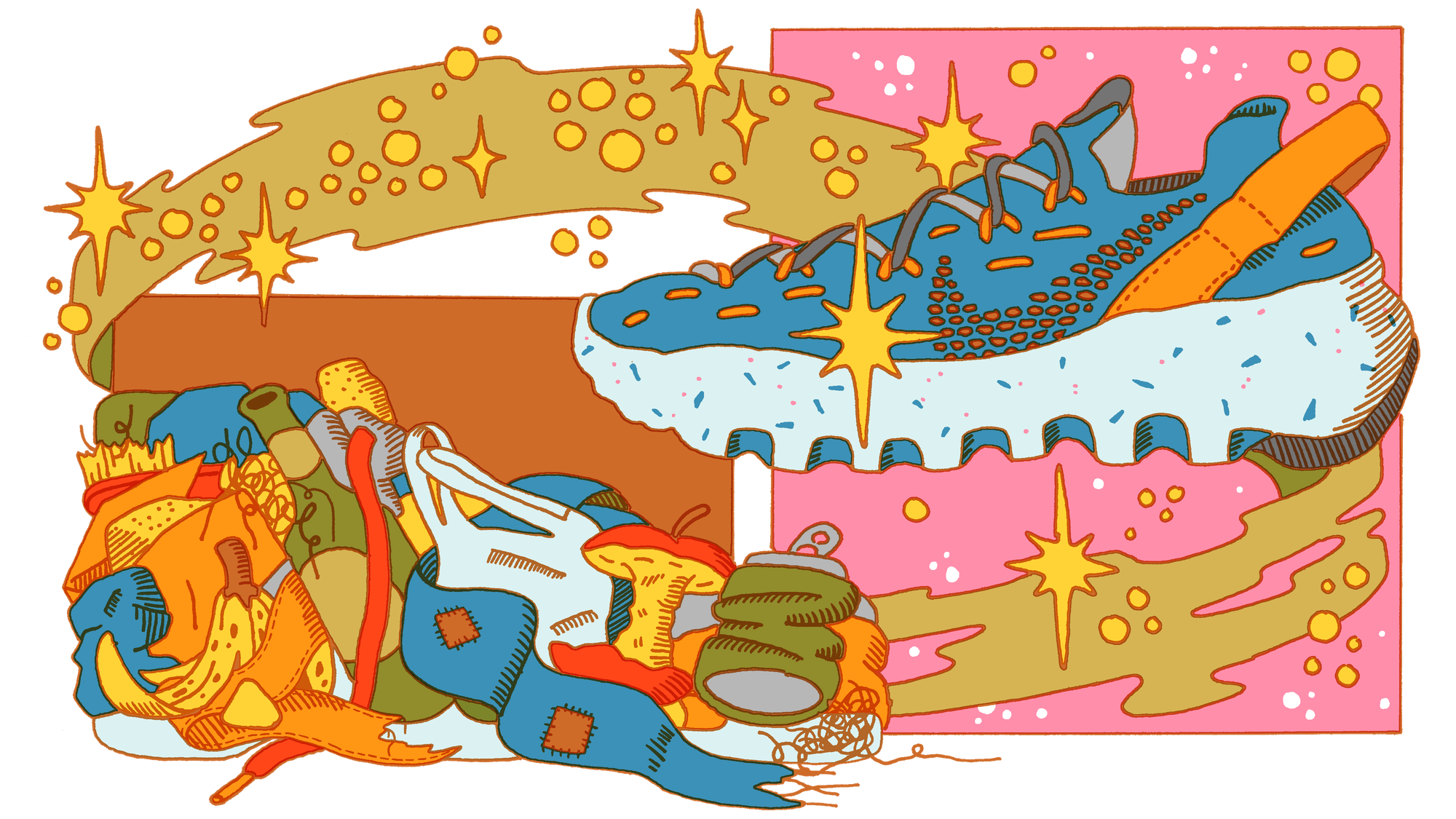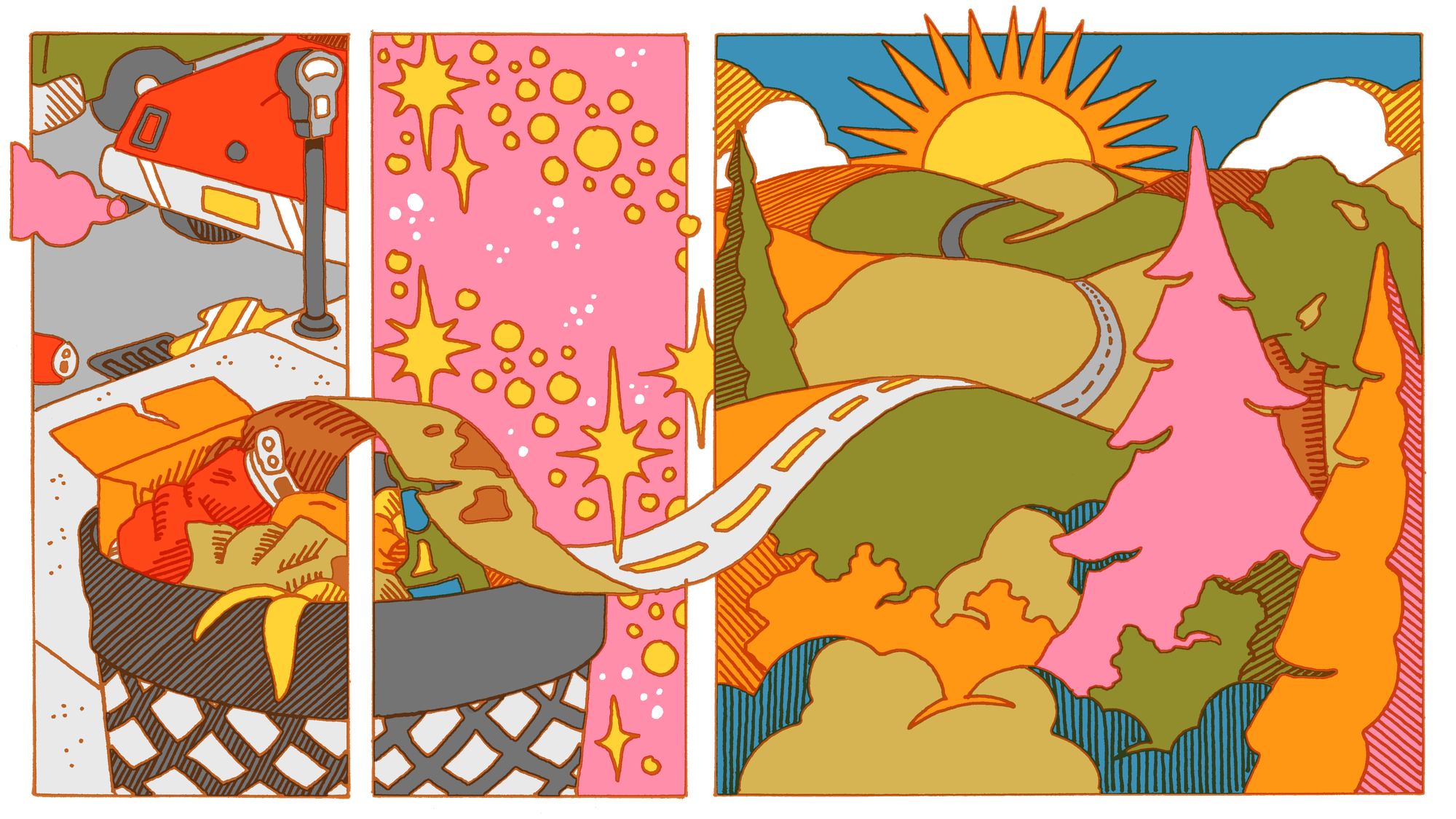Trash Talk
Two leaders in the shift toward the circular economy—at a NYC nonprofit and Nike—discuss the trials and triumphs of the quest for zero waste.

Within the five pounds of waste that the average American produces each day is a virtual gold mine of possibility: organic materials that could be composted; plastics that could be recycled, valuable minerals and metals that could function quite brilliantly in new technology.
The problem of waste is one that involves a lack of imagination, or at least an unimaginative reliance on an old paradigm—that we can throw away items that required labor, energy, and resources to create or grow, even though so much of this so-called garbage could have a second life: construction waste can be culled to gather raw materials for yet another cycle of construction; throwaway or even “recyclable” packaging can be eliminated entirely by creating containers or packaging meant to be returned and reused. Relying on virgin materials is far more energy intensive than reuse, and eliminating waste results in a reduction in both greenhouse-gas emissions and resource depletion, aiding the effort to limit global warming.
Our collective imagination—spurred by advocacy, government, and business initiatives—is shifting to embrace the zero waste and regenerative framework. In addition to old standbys like Terracycle, new businesses like Evrnu, Loop, and ByFusion are pushing the effort forward; the venture capital group Closed Loop Partners specifically funds circular economy enterprises.
Julie Raskin, executive director of the New York City Sanitation Foundation, and Noah Murphy-Reinhertz, sustainable design lead of Nike’s NXT Space Kitchen team, are pioneers of imagining, and implementing, the future of zero waste. Both are working to achieve ambitious goals: NYC is aiming to significantly reduce its waste even as population increases, and Nike is aiming to reach targets for reducing carbon footprint, water use, waste production, and hazardous chemicals by 2030, with a further goal of achieving net zero emissions and zero waste by 2050. Building on their tireless curiosities about waste, the role of design in catalyzing shifts, and the possibilities of regeneration, Raskin and Murphy-Reinhertz are cutting back on trash while reconceiving the very notion of it.
At the Sanitation Foundation, Raskin uses education, public outreach, and capacity building to engage New Yorkers in waste reduction efforts, while cultivating appreciation for NYC’s sanitation workers and their work. At events like the Food Waste Fair and ReFashion Week, audiences gain inspiration from experts, businesses, and innovators who specialize in reducing “refuse” of various forms, while the organization’s Zero Waste Academy, which debuted in 2021, is a master class on New York’s waste infrastructure and organizations pioneering circularity in the city—from a nonprofit that runs a 1+-million-pound composting operation to a company that recycles construction waste using an ingenious, industrial-strength Rube Goldberg contraption to sort materials. Raskin is showing what future systems and patterns can look like for New York and the other metropolises that look to it for leadership.
At Nike, Murphy-Reinhertz is spearheading game-changing products like Space Hippie, a shoe that features upcycled components, including yarn made from recycled plastic and textile waste, and soles incorporating cast-off rubber and foams that Nike previously threw away. His team’s all-encompassing mission is to reconsider every element of Nike’s design and production operation, to accelerate the company’s movement into a circular orientation: eliminating waste through using recycled materials, increasing production efficiency, and designing for zero waste from the outset. These strategies inform Nike’s Next Nature initiative, in which recycled components are integrated seamlessly into classic footwear with a focus on performance sports and additive technologies like 3D printing and Flyknit, a hyper-efficient technique of weaving shoe uppers from recycled materials.
Fulfilling another prong of Nike’s zero waste strategy, Murphy-Reinhertz’s most recent debut reduces waste by helping wearers extend the life of their shoes, through a precision refurbishing robot named B.I.L.L., for Bot Initiated Longevity Lab. His team’s work has inspired other Nike zero waste designs, like shoes made to be taken apart, so that materials can be easily reclaimed at the end of their lifecycles, transformed into feedstock for other products. As a designer with deeply honed problem-solving skills, Murphy-Reinhertz is creating innovation in a way that is vibrant for consumers, while working within the framework of Nike’s highly complex production and logistics systems.
In this conversation, Murphy-Reinhertz and Raskin explore what they’ve discovered at the frontier of circularity.

Julie Raskin and Noah Murphy-Reinhertz discuss pragmatic solutions and worldchanging visions essential for accelerating the zero waste paradigm.
Julie: In talking about this issue, the choice of language reflects our deeper ideas about this effort: there’s zero waste, circularity, regenerative culture. What feels to you like the most vibrant way to discuss this topic right now?
Noah: Almost everybody who’s engaged in this kind of work is pretty dissatisfied with the term sustainability, because we actually don’t want to sustain what we’re doing today. That’s what’s taken us off the cliff. At Nike, we’re interested in circularity as a construct for, “How do we run a business in a way that mimics or syncs with the natural systems?” But even when we speak about the concept of circularity, it can have a very technical feel, as though we’re going to have a circular system where there’s a perfect flow of material into use and back again, and it’s going to keep going forever. That term also lacks the nurturing element that working with Earth’s natural system requires. I think regeneration comes into focus when we start to think about the natural systems that might feed a circular system.
What are the terms that feel most relevant to your work?
Julie: There are 8 1/2 million New Yorkers and different audiences respond to different nomenclature. Sometimes we talk about waste diversion. Sometimes, instead of communicating that people should stop doing something, we frame it as, “Start doing something, by doing something productive with this material.” Sometimes we put this zero-waste effort in the context of how to save money, of being thrifty.
What sorts of messages do you feel resonate the most with Nike consumers—are people drawn to products like Space Hippie because they want to support aspirational social change? Or is it just because that’s the shoe that fits them best and allows them to run their best race?
Noah: At Nike, we come from a point of view of listening to the athlete and often that means we’re focusing on sports performance. We’re trying to understand everything from mental to physical performance, and how we can enable those. But any time you’re making something new, you can’t ask people, “Tell us the shoe to make.” Because their response generally is to defer to us: “You’re Nike, you’re the ones who are really good at making shoes.”
So, what we did was try to get a sense of the mood out there around climate change. There was a sense of, not hopelessness, but lack of empowerment to be effective in change. People were telling us, “If I go down the street to a smoothie shop, I can choose the one that is bringing locally sourced produce. But if I’m trying to buy a car or if I’m trying to buy clothing, my options are much more limited to what the market is offering.” Our first thought, then, was that our audience has this connection to the brand, but they want to feel part of the right choice. That was a big dimension of Space Hippie. Using a lot of recycled materials in a way that was very transparent was just about communicating, “These things that we stand for, sometimes they’re in the background—but we can put them right up front and that makes it very easy for people to make a choice and feel good about it.”
We have to reinvent the system behind things, not the things themselves. If you can’t change the existing tools, then you can’t fundamentally change the future.
Noah Murphy-Reinhertz
Sustainable Design Lead
NXT Space Kitchen, Nike
Julie: I’m curious about the internal cultural workings at Nike. I assume in some ways it’s similar to the city where, when the mayor wants a certain policy, it happens, but sometimes it bubbles up from the bottom through local council members or residents. With a project like Space Hippie and zero waste goals at Nike more broadly, where did that start and how is that being messaged up or down?
Noah: It’s a mix of both. That’s the easy answer, but how that comes to life is much more interesting and nuanced. The big goals that Nike has are aligned to science-based targets. If we’re going to be in line with climate targets trying to limit our contribution to global warming, then that comes down to a certain percentage reduction in carbon emissions, and those can be broken down into averages across the whole company specifically relating to carbon, waste, water, chemistry, labor. What’s wonderful about Nike is that within the company, we have different types of cultures and experts who are going to come at those goals very differently. There are some material scientists who are going to start to think very specifically about, “Should I accomplish that through reducing the energy requirements of this foam molding?” And then you get machine process people who will ask, “Okay, instead of heating up a block of steel for this part of the production, could I just heat up the surface of that steel?”
And then you get people like myself who are trying to create a whole consumer-facing concept—something that people can buy. An easy way to think about this is by considering the components: there’s the top of the shoe, the bottom of the shoe, there’s a way to put those pieces together, and then there’s something that people can buy at the end of the day. Within the Nike innovation group, there are people trying to reinvent each part of that process.
As all this starts bubbling up, we have to examine where these things fit in: What other part of the business do they affect? And are we evolving something that already exists or are we trying to totally supplant it? What seemed to be least disruptive initially was to use things that we were already producing in abundance, such as textile scrap. Everybody involved in the supply chain understands this is waste, so they’re very welcoming to the possibility that we can do something with it. The same went for foams we were cutting. People were very excited that we were going to take that and put it into a shoe. And then as designers, we can see that if we use those materials in this way, the shoe will have a unique aesthetic. When you put the product on the table and people can see it, that’s what catalyzes them to action.
Julie: Were there competing factions working on different options, and you had to be the arbiter of what’s sellable?
Noah: When you have something that’s really new like the ingredients for Space Hippie or Next Nature, the question that comes up often is, “Do we put those ingredients into something that’s already a cultural icon, or do we try to make a whole new expression?” We have to be pushing the edge and also bringing along this element of heritage and culture that has made Nike what it is. And for our icons, we need to find new methods of production that allow it to be better and better—and that’s what we call “invisible innovation.”
What’s your take on innovation? If the Department of Sanitation is a government organization whose job is to solve the waste issue—what’s the role of this nonprofit?

Julie: When she hired me, Kathryn Garcia, the former NYC Sanitation Commissioner, said, “I want you to do the cool shit that government can’t do that gets across the mission of zero waste.” So sometimes we organize fashion shows, or we organize cook-offs where chefs try to make the best dish without throwing anything away. We’ve organized events like the Food Waste Fair, where we gather together leaders from this field and host a showcase of products, foods, and businesses all related to food waste. We’re now exploring some ideas focused on technology that we can pilot for the city, because it’s extremely hard for a government agency to get the go-ahead from the central office of management and budget to buy big equipment if they don’t have a proven use case. In that sense, we can pilot innovation.
Sometimes, too, government is intimidating. And in turn we hear feedback that we’re a gateway for people to learn and to make connections: The Waste Academy is a good example of that—you’re able to come into this welcoming environment and hear from some government leaders, some private leaders, and ask all of your burning questions. Through this, you figure out how you could be a better participant in the system. So in some cases we’re doing what government can’t, but in others we’re pushing things forward and working in tandem with the government.
Noah: We have found nonprofits can be the convening spaces that allow companies like ourselves, our competitors, and adjacent industries to come together and do things that we all know need to happen, but aren’t necessarily easy to navigate, because you don’t have many companies that conclude, “It’s clearly in our best interest to develop this partnership with a competitor.” Working with nonprofits or with external knowledge creators in a sustainability space creates a neutral space for brands to come together and do things that might be difficult to do directly or on our own.
I see a role for every sector in this journey to zero waste, and so much of my job now is bringing everyone together and finding those connections.
Julie Raskin
Executive Director
New York City Sanitation Foundation
Julie: How has sustainability been a driving force for you?
Noah: Being here on the West Coast, nature was always a part of my life. But at a certain point as a designer, I was doing consumer electronics, and I realized that the plastics in most of these things are going to last forever. So what could I do differently? The challenge with being an independent designer and a consultant is you have freedom to do anything you want, but you don’t have the allies and the weight to make systems-level change.
When Nike came out with the first Flyknit shoe in 2012, I thought, “Wait a minute. This is made completely differently. It’s not cutting things with scissors and having leftovers.” It’s knit like your grandma would knit a sweater. And I realized, “Whoa, this is completely changing the manufacturing process of something.” I didn’t come to Nike until 2015, but that planted this seed of understanding that what’s necessary is to reinvent the system behind things, not the things themselves. When you can’t change the existing tools, then you can’t fundamentally change the future.
What’s your zero waste origin story?
Julie: I’ve always been drawn to commerce and capitalism, as well as public service and improving the city and the lives of people around me. I studied urban planning and environmental sustainability and science in college, and I spearheaded some recycling programs when I started my first job at the New York City Parks Department, so I think the waste piece has always been part of my practice and my ethos.
I see a role for every sector in this journey to zero waste—business, government, nonprofit, community organizations—and so much of my job now is bringing everyone together and finding those connections. We particularly like to spotlight small local businesses in New York that are doing the right thing and could benefit from a bigger audience.

Noah: Tell me about some of the ReFashion events that you organize—are there some designers or projects that you would point us towards, if you were going to share some stuff with Nike?
Julie: A couple things come to mind immediately. One of our partners has been involved with running his family leather business and began to shift his work when he had an epiphany about waste. Before New York banned plastic bags, there would be places you could bring your plastic bags for recycling; he collected plastic bags and wove them into a kind of fabric to make tote bags that are really stylish. His first commercial opportunity was at our ReFashion Week, at a pop-up marketplace where designers that don’t have a brick-and-mortar store could have an audience for a day.
We tend to get press and other attention, because people are baffled by the Department of Sanitation doing a fashion project. We use that audience to champion and give a platform to these smaller designers. So, he got recognized there and then the business took off.
As you’re thinking of the shifts you’ve seen and that we need to create, what message do you share with people who want to catalyze this area of zero waste and circularity?
Noah: We’ve found it important to tell people to try holding two things in your mind at the same time. One is to work with the things that you’ve got today. What that means is, to get involved and motivated and have fun making an impact now. You have to start today—doing things like walking your food waste down to one of the composting drop-offs. Work with what you’ve got and get engaged creatively with that.
But then at the same time, hold in your mind the ideal future, so that the steps you’re taking now are actually headed toward that—and not just existing in the current paradigm. And also continue thinking about that future and be totally wild about it. People tend to think of innovation as the far future, but you won’t get there if you aren’t actually working right now with what you’ve got available to you. ❤
At Kazam! Magazine we believe design has the power to change the world. Our stories feature people, projects, and ideas that are shaping a better tomorrow.